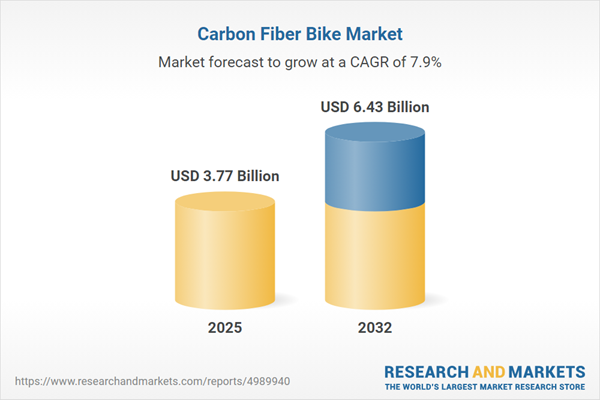Speak directly to the analyst to clarify any post sales queries you may have.
The carbon fiber bike market is rapidly evolving, with brands integrating advanced materials and technologies to meet shifting customer demands. Senior decision-makers must align their strategies with these changes to ensure leadership in a competitive, specialized landscape.
Market Snapshot: Carbon Fiber Bike Market Growth and Outlook
The global carbon fiber bike market is set for robust revenue growth between 2024 and 2032, supported by a strong compound annual growth rate (CAGR). Professional athletes and recreational riders increasingly choose carbon fiber bikes for their lightweight design and superior performance. Manufacturers leverage advances in composite technologies and innovative bike designs to deliver solutions that fit a broad spectrum of user requirements. Distinct regional cycling trends influence business strategies, prompting companies to tailor product offerings and marketing approaches at both local and international levels. As the pace of sector innovation accelerates and market expectations shift, maintaining agility and a forward-looking approach remains essential for success.
Scope & Segmentation
- Bike Types: Hybrid bikes are designed for commuters and leisure riders requiring adaptable everyday mobility. Mountain bikes focus on resilience and reliability for off-road riding in demanding terrains. Road bikes target long-distance users and competitive cyclists, as well as regular commuters and triathletes.
- Fiber Composition: High modulus carbon fibers deliver enhanced rigidity and reduced frame weight for high-performance needs. Intermediate modulus varieties achieve a balance between strength and flexibility, while standard modulus fibers serve the entry-level and budget-conscious segments by providing accessibility and value.
- Customer Profiles: Product development addresses the unique needs of professional athletes, while also ensuring user-friendly features for lifestyle cyclists and occasional riders. This inclusive strategy supports broader adoption across all experience levels.
- Distribution Channels: Companies extend market reach using brick-and-mortar retailers, dedicated niche outlets, ecommerce platforms, and leading online marketplaces to meet evolving purchasing preferences.
- Geographical Coverage: The market spans the Americas, Europe, Middle East & Africa, and Asia-Pacific with strategic focus on distinct markets such as the United States, China, Germany, and Brazil. Regional portfolios align closely with local regulations and prevailing consumer trends.
- Key Companies Profiled: Major industry participants such as Giant Manufacturing Co., Trek Bicycle Corporation, Specialized Bicycle Components, Merida Industry Co., Scott Sports SA, Cannondale Bicycle Corporation, Canyon Bicycles GmbH, Bianchi S.p.A., Pinarello S.p.A., and Colnago Ernesto & C. S.r.l. drive advancement by pushing technical benchmarks and modernizing production processes.
Key Takeaways for Senior Decision-Makers
- Innovative carbon fiber frame engineering enables brands to offer differentiated products that blend balanced strength, customization, and performance.
- Growth in modular frame designs and adjustable components opens new opportunities for product personalization, appealing to a wider base of cycling enthusiasts.
- Increased automation and robotics adoption throughout manufacturing improves efficiency and accelerates responsiveness to evolving market requirements.
- Sustainability efforts, including recycled fibers and closed-loop systems, support adaptation to regulatory changes while reinforcing corporate responsibility commitments.
- Investment in cycling-friendly infrastructure expands participation, motivating ongoing product diversification and reaching untapped user segments.
- Expanded collaborations and industry partnerships promote broader technology access and stimulate opportunities for joint development agreements and technology licensing.
Tariff Impact and Supply Chain Strategy
Fluctuating international tariffs are introducing new challenges within the supply chain. To mitigate potential disruptions, manufacturers diversify supplier bases and invest in regional production hubs, strengthening operational resilience. Vertical integration and expanded local sourcing also improve compliance and continuity, ensuring more stable operations in a dynamic trading environment.
Methodology & Data Sources
This analysis relies on primary research methods, such as interviews with business leaders and technical specialists, alongside a review of industry publications, technical documentation, and intellectual property records. Cross-referencing findings through data triangulation further enhances the credibility of insights and supports high-level strategic decisions.
Why This Report Matters
- Enables leadership teams to pinpoint growth opportunities and evaluate emerging technologies that optimize efficiency in the carbon fiber bike sector.
- Supports data-driven decisions regarding investment, partnerships, and market expansion, with tailored strategies for adapting to new regulations and evolving buyer preferences.
- Equips executives with actionable insights on customer dynamics and region-specific trends to refine business strategy and maintain compliance in an increasingly complex industry environment.
Conclusion
Ongoing progress in carbon fiber technologies and bike design defines the trajectory of this market. Senior leaders who employ adaptive, evidence-based strategies are positioned to successfully navigate new opportunities as the industry continues to evolve.
Additional Product Information:
- Purchase of this report includes 1 year online access with quarterly updates.
- This report can be updated on request. Please contact our Customer Experience team using the Ask a Question widget on our website.
Table of Contents
3. Executive Summary
4. Market Overview
7. Cumulative Impact of Artificial Intelligence 2025
Companies Mentioned
The companies profiled in this Carbon Fiber Bike market report include:- Giant Manufacturing Co., Ltd.
- Specialized Bicycle Components, Inc.
- Trek Bicycle Corporation
- Merida Industry Co., Ltd.
- Scott Sports SA
- Cannondale Bicycle Corporation
- Canyon Bicycles GmbH
- Bianchi S.p.A.
- Pinarello S.p.A.
- Colnago Ernesto & C. S.r.l.
Table Information
| Report Attribute | Details |
|---|---|
| No. of Pages | 190 |
| Published | October 2025 |
| Forecast Period | 2025 - 2032 |
| Estimated Market Value ( USD | $ 3.77 Billion |
| Forecasted Market Value ( USD | $ 6.43 Billion |
| Compound Annual Growth Rate | 7.9% |
| Regions Covered | Global |
| No. of Companies Mentioned | 11 |









